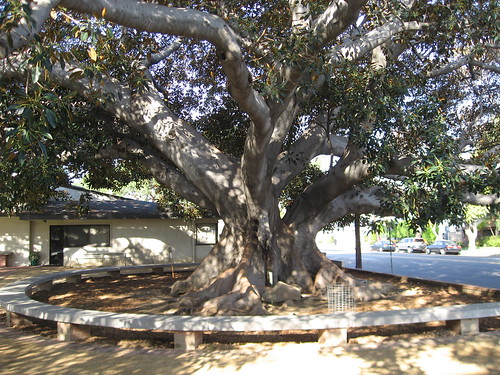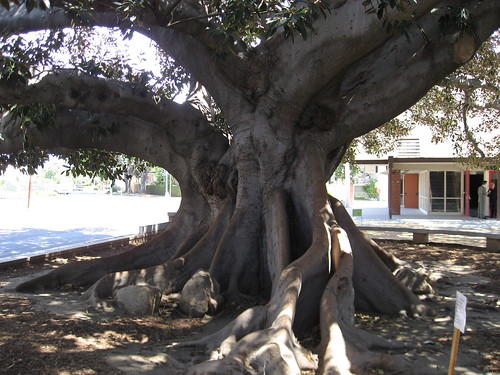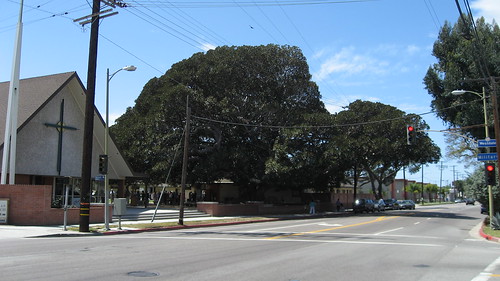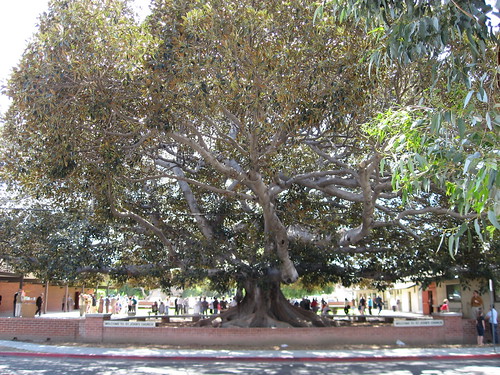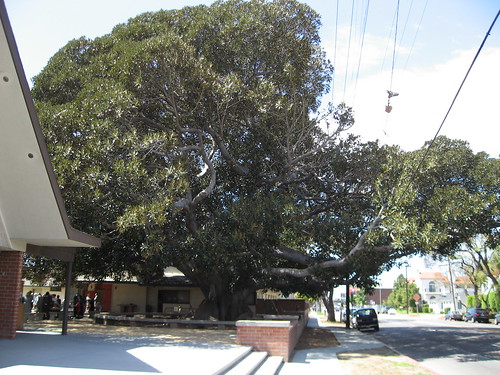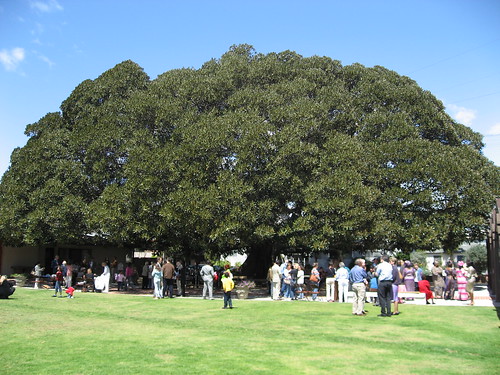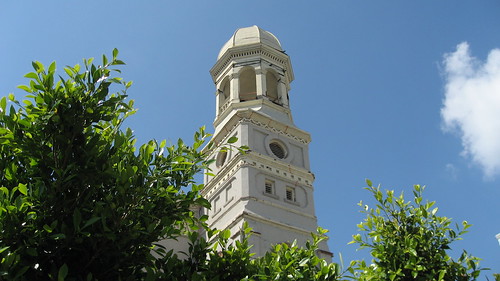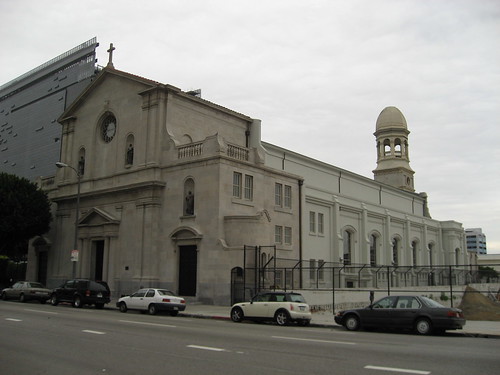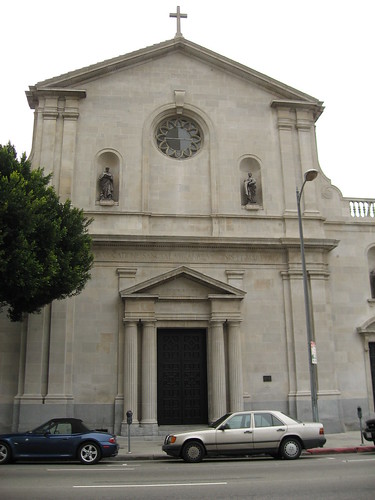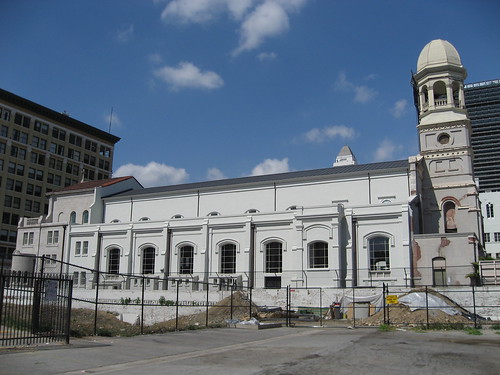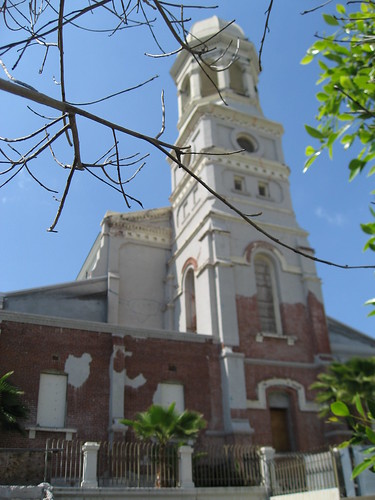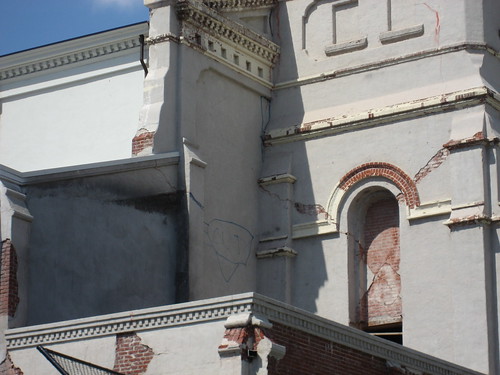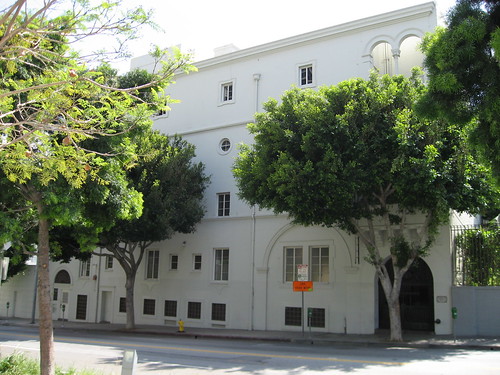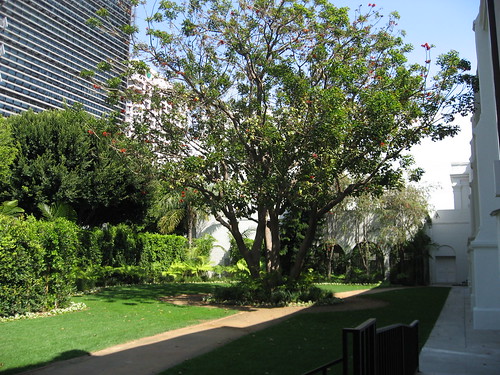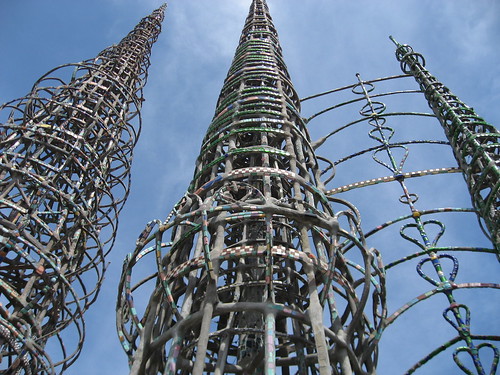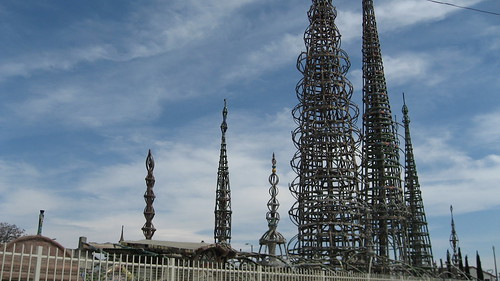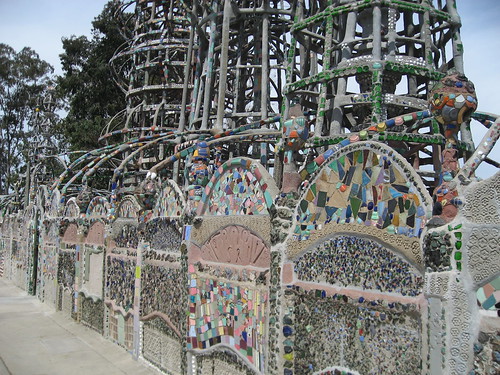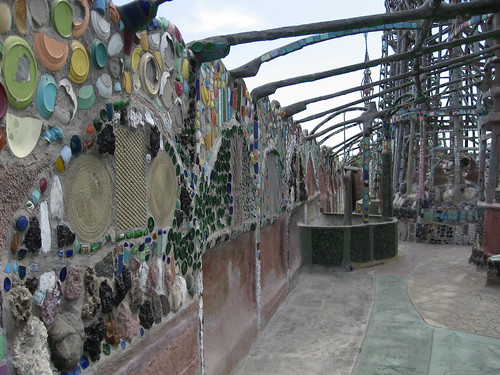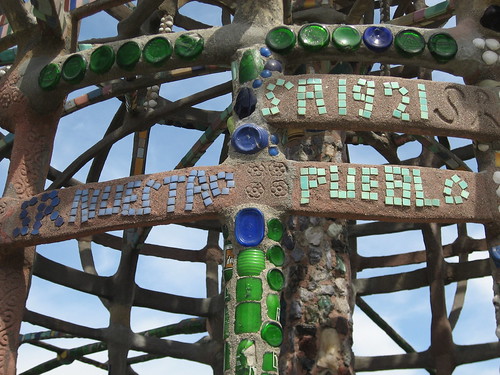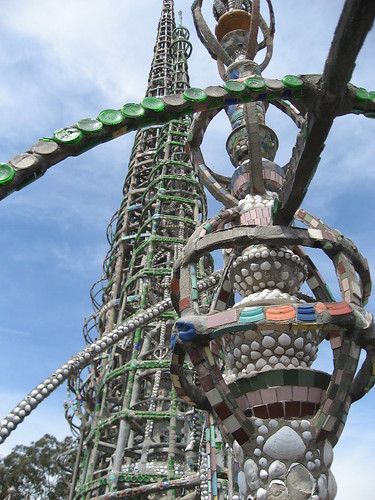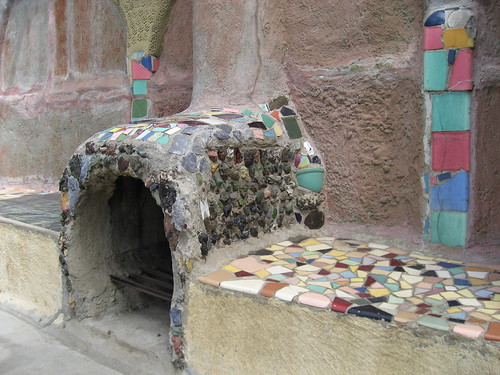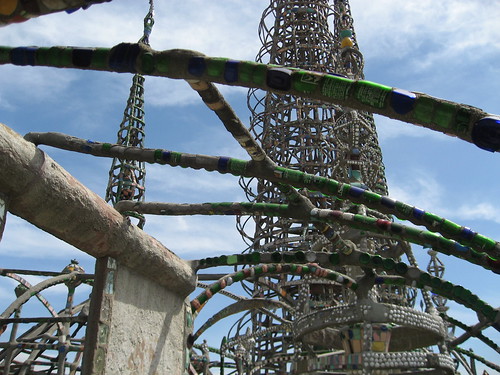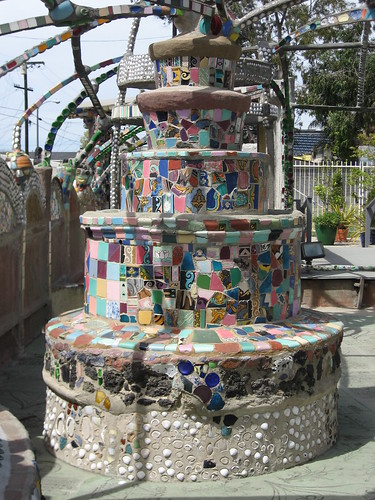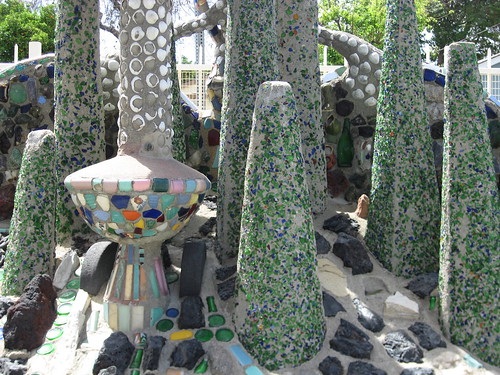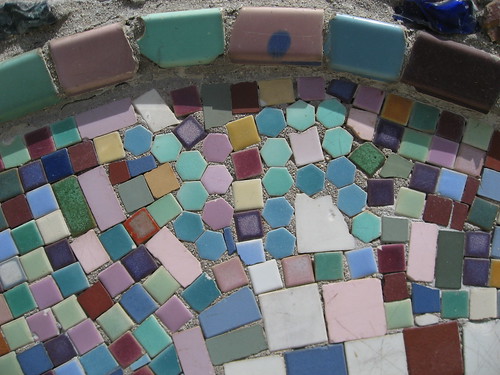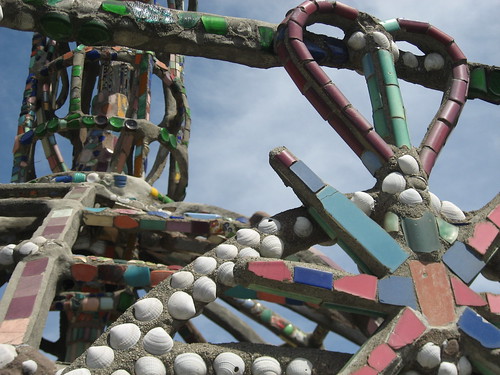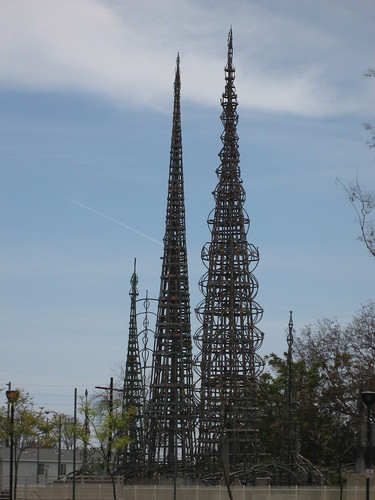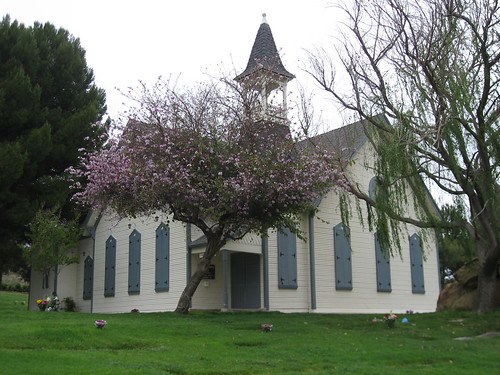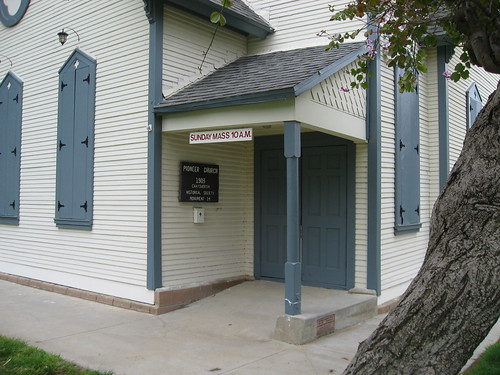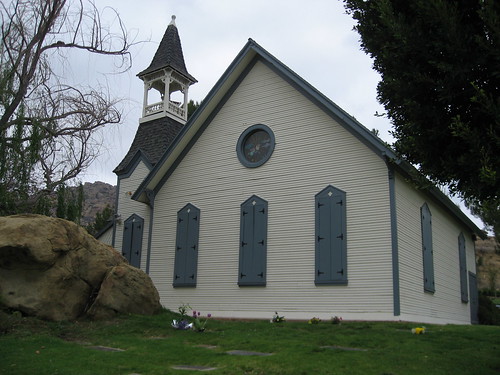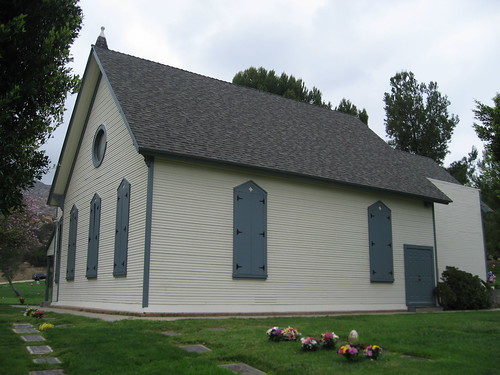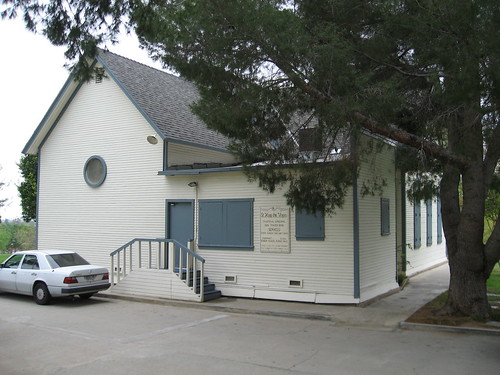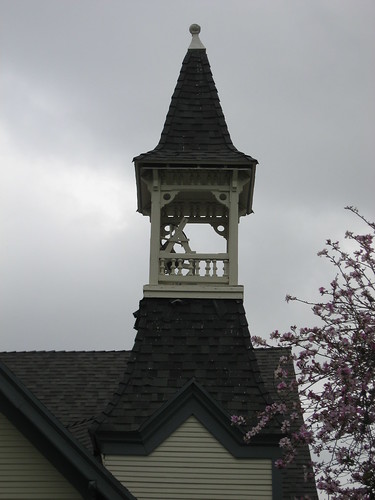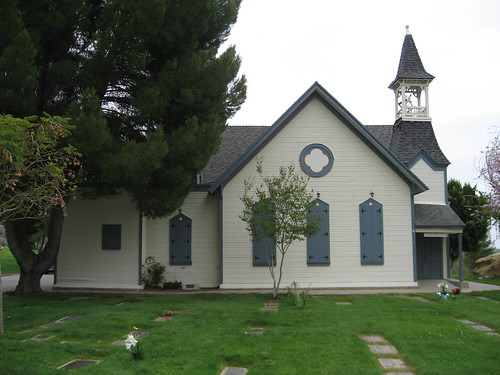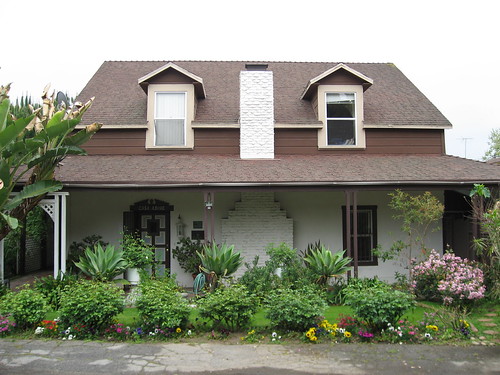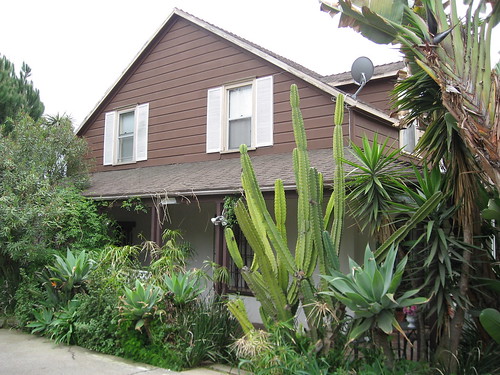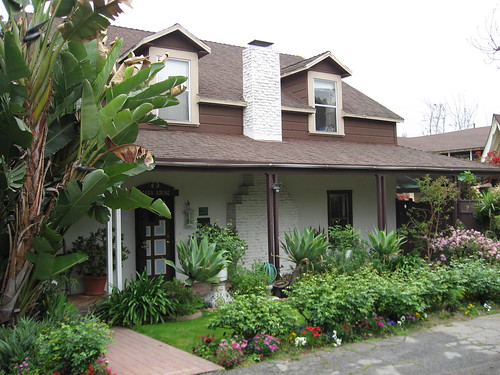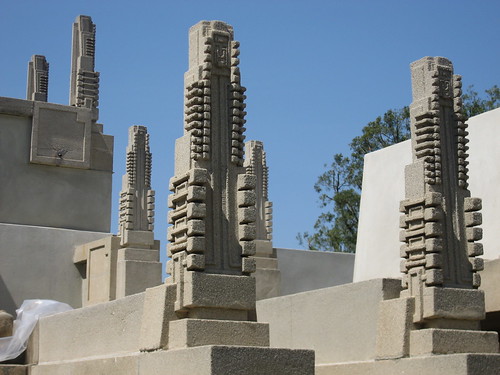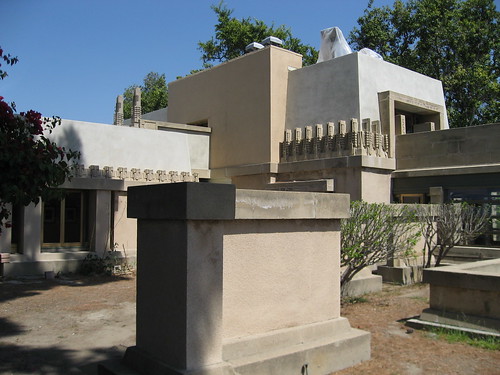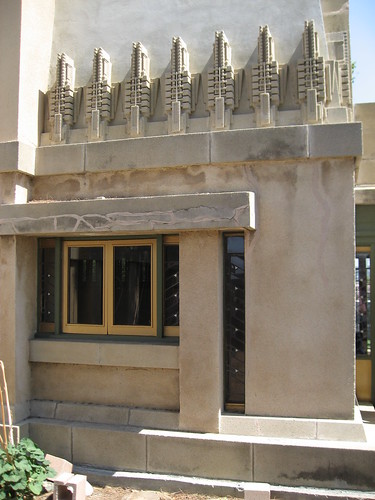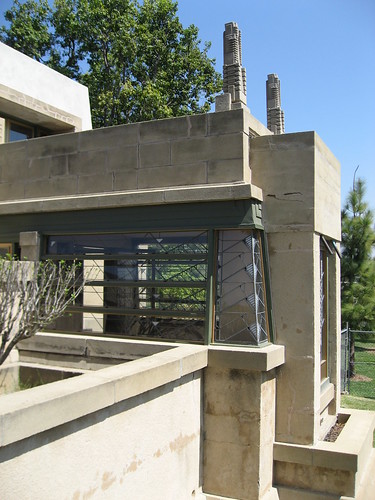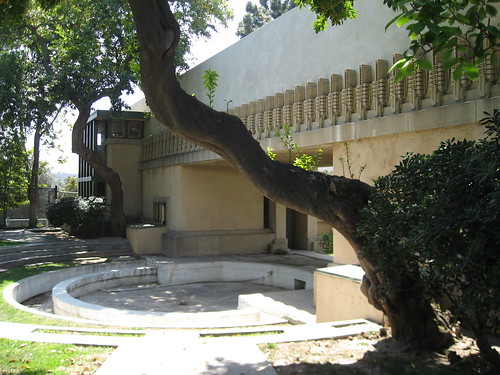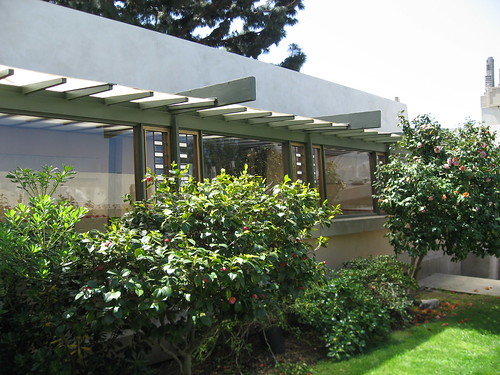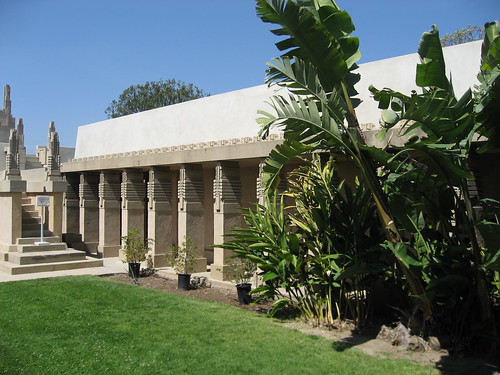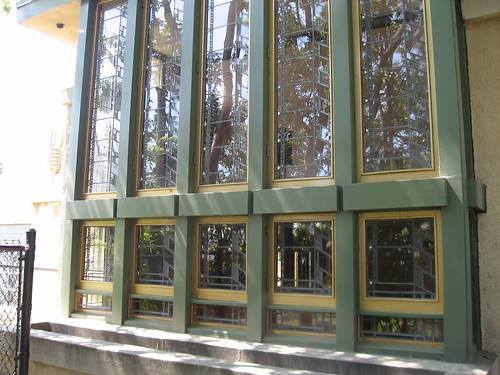Sunday, April 29, 2007
No. 19 - Moreton Bay Fig Tree
Moreton Bay Fig Tree
1875
11000 National Boulevard – map
Declared: 5/10/63
Okay. So after a string of churches at Nos 16, 17, and 18, we get, at No. 19, a tree. Now, it’s a big tree, a Moreton Bay Fig Tree, a Ficus macrophylla, an Australian evergreen, planted in 1875. McGrew and Julian, in Landmarks of Los Angeles, report it was planted by the Smith family, shading their La Balloona Ranch cottage. It’s now part of the grounds of St John’s Presbyterian Church in Westdale, and it still covers the area with figs after all these years.
As big as this Moreton Bay Fig Tree is, it’s not in the same league as the ones in San Diego and Santa Barbara (the largest in the nation). Both of those are listed in the California Registry of Big Trees. If Moreton Bay Fig Trees rock your world, go see the beauty at Santa Monica’s Fairmont Miramar Hotel.
While St John’s and the city have worked for preservation of the tree – cutting down other trees in the area to allow canopy growth, for example – you’d think they’d figure out an alternative to gouging out a huge hunk of the landmark tree for overhead wires right-of-way:
Up next: Two Stone Gates
continue reading...
Posted by
Floyd B. Bariscale
at
10:01 PM
3
comments
![]()
Labels: Palms/Del Rey/Mar Vista
Thursday, April 26, 2007
No. 18 - Hyde Park Congregational Church

Hyde Park Congregational Church
1901
Former location: 6501 Crenshaw Boulevard
Declared: 5/10/63
Yet another Los Angeles Historic-Cultural Landmark that isn’t there anymore. However, HCM No. 18 has the dubious distinction of being the first landmark to bite the dust after the declaring process began in August, 1962.
According to McGrew and Julian’s Landmarks of Los Angeles, Capt. and Mrs Fred B. Clark donated land at the turn of the last century for the church. It was razed in 1964.
The congregation’s website says the old church was dedicated March 10, 1901, but the following Los Angeles Times article from February 11, 1901, reports dedication ceremonies were held the previous day, respectively.NEW CHURCH BUILDING.
Dedication of the Hyde Park Congregational Edifice Yesterday Afternoon. A Memorial to Cora Clark.
The pretty edifice henceforth to be known as Hyde Park Congregational Church was dedicated yesterday with suitable ceremonies.
The building was erected by Capt. and Mrs. F.B. Clark, in memory of their daughter, Cora, who died several years ago. Some 250 people gathered to witness the ceremonies and to listen to the dedicatory sermon delivered by the Rev. W.A. Lamb. The Pico Heights Congregational choir, under the leadership of W.E. Herendeen, rendered several anthems, Mrs. Charles Durkee singing “The Holy City.”
The church has a main auditorium with 50 seats, besides a Sunday-school room and gallery, which hold fifty additional. It is a neat frame building, with Gothic windows and natural pine ceiling. There are a pulpit, choir platform, concealed baptistry and pastor’s study. The exterior is attractive, the roof having two towers. At one side of the church is a beautiful window, costing $100, placed there in memory of Miss Bertha Leuzinger, a former worker in Endeavor Society, who died two years ago.
The Hyde Park people have been holding services for twelve years in the school building, and since 1890 Rev. J.M. Schaefle has presided as pastor, holding a Sunday-afternoon service there, as well as a Friday-night meeting. During this time Mr. Schaefle has also presided over the congregation of the Pico Heights Congregational Church, holding four Sunday services there, as well as one week-night meeting. The preacher will continue to serve both charges.
You know, you just don’t see the L.A. Times referring to a “pretty edifice” that much these days. Or anyone else, for that matter.
The current facility opened in 1965.
The photo's from the city's Department of City Planning website.
Up next: Moreton Bay Fig Tree
Posted by
Floyd B. Bariscale
at
8:19 PM
1 comments
![]()
Monday, April 23, 2007
No. 17 - St Vibiana's Cathedral
St Vibiana’s Cathedral
1876 – Ezra Kysor and W.J. Mathews
114 East Second Street – map
Declared: May 10, 1963
The Cathedral of Sancta Vibiana, modeled after the architecture of Puerto de San Miguel in Barcelona, was built in the 1870s on land donated by a guy named Amiel Cavalier. Opening on April 9, 1876, it became the home of the Archdiocese of Los Angeles and it replaced Iglesia Nuestra Señora Reina de los Angeles as the city’s main Roman Catholic church. Pope Pius IX named St Vibiana’s for a third century martyr (the martyr St Vibiana - the poor girl was flogged to death). With the help of its 83-foot bell tower, the Spanish-Baroque church instantly became a dominant part of the city’s skyline.
While the site's cornerstone was put down in 1871, Harris Newmark, in his book, Sixty Years in Southern California, says
... the first corner-stone had been placed, on October 3rd, 1869, on the west side of Main Street between Fifth and Sixth, when it was expected that the Cathedral was to extend to Spring Street. The site, and that oddly enough, was soon pronounced, "too far out of town", and a move was undertaken to a point farther north.In 1933, a five-story rectory was built on the Second Street side with living quarters, kitchens, dressing areas, and balconies. Pope John Paul II stayed there during his 1987 trip to Los Angeles.
After the 1994 Northridge earthquake, parts of the cathedral were severely damaged. In 1996, the Archdiocese of Los Angeles began demolishing the structure, starting with the bell tower, to make way for a new church. The Los Angeles Conservancy and executive director Linda Dishman, with support from Antonio Villaraigosa, then Assembly Speaker and a former Vibiana altar boy, State Senator Tom Hayden, and State Senator Gil Cedillo, opposed the destruction. A pair of lawsuits halted demolition. However, Cardinal Roger Mahony threatened to move the cathedral out of downtown L.A. if he couldn’t raze and replace old St Vibiana’s.
The archdiocese ultimately backed down when, first, it acquired from the city a plot at Temple and Grand for a new church (Cathedral of Our Lady of the Angels opened in 2002) and, second, developer Tom Gilmore stepped in and bought St Vibiana's for $4.65 million. (More money: the 21st-century cathedral cost around $200 million; the 19th-century church around $80,000.) Read an account of the archdiocese/preservationists to-do here.
After a restoration and seismic retrofitting costing around $8 million, the building was re-opened as an events center, Vibiana Place, with a big wing-ding on November 12, 2005.
As late as last fall, Gilmore's plans for the site included a restaurant in the rectory, the performing arts center in the church, and an adjoining 41-story building with 300 condos.
When I was there, the place was shut up pretty tight, so I didn’t get any pictures of the inside. But if you go to the Vibiana Place website, you’ll see some great interior shots.
8/29/07 Update: Click here for a Los Angeles Times article, with footage, on the restoration of the 3,500-pound cupola.
Up next: Hyde Park Congregational Church
continue reading...
Posted by
Floyd B. Bariscale
at
8:42 PM
3
comments
![]()
Labels: Central City
Friday, April 20, 2007
No. 16 - St Joseph's Church

St Joseph’s Church
1901 – Brothers Adrian and Leonard
Original Location: 218 East 12th Street
Declared: 5/10/63
Okay. The first thing you should know about St Joseph’s Church is that it isn’t there anymore. It burned down just before first Mass on September 4, 1983, due to a glitch in the subfloor wiring. No one was injured, and the adjacent rectory with its twenty-one Franciscan priests wasn’t damaged.
The roof collapsed, but the brick walls and the two five-story bell towers remained standing. Also, some things inside were spared, like the lead in the stained windows, a couple of statues and pictures, confessional doors, a few pews, and the antique vestments.
The Cultural Heritage Board tried to convince the archdiocese into at least incorporating the remaining steeples and walls into the planned replacement church, but, in mid-October, the city approved a demolition permit saying what was left of the old church was a safety hazard to the public.GRAND DEDICATION FOR ST. JOSEPH’S CHURCH.
B&W photo source: Los Angeles Department of City Planning
APOSTOLIC DELEGATE D. FALCONIA TO OFFICATE.
Church Dignitaries from South and West Will Be Present—Rich Interior Furnishings—Wonderful Fresco Work and Art Work from Europe.
Behind the closed and barred oak doors of the new St. Joseph’s Church, at the corner of Twelfth and Los Angeles streets, a great transformation scene is in progress.
The vast interiors of the great church is a labyrinth of trestles and scaffolding, reaching clear to the crown of the ceiling, sixty-two feet from the main floor. But peeping through the interstices and lattices of the heavy timbers, one may discover a wondrous work of gilt, and the deep tones of reds, greens, blues and yellows assembled with an artist’s touch into a magnificent whole.
This extensive fresco work, said to be the finest on the Coast, is being wrought out by Prof. William Kloer and his corps of assistants, who came from St. Louis, Mo., for this purpose. Prof. Kloer has spent years in this line of work, and has been in charge of the decoration of some of the finest Catholic buildings in the United States.
For almost three months these men have toiled on the extensive work at St. Joseph’s sometimes far into the night, and they count on a full three weeks of hard work yet before the frescoing will be completed. While the walls have been receiving most of the work, there are yet to be painted several scenes on canvas, which will adorn the great arches in the center of the ceiling. Two large medallions, eleven feet in circumference, will have the center spaces, on being a scene of St. Joseph blessing Pope Pius IX, and the other St. Francis receiving the indulgence.
A RICH INTERIOR
When all the appointments of the new St. Joseph’s Church are in place it is said there will be no finer church edifice on the Pacific Coast. The whole building is to cost $100,000, and aside from this the furnishings make no small item.
Seven beautiful altars will be placed in the new building. These have been made in Munich, and are now in New York. They are of white walnut, and finished in white and gold. The main altar, of pure Gothic design, is forty-seven feet high, and the side altars are thirty and twenty-eight feet high.
The communion rail is also to be of polished walnut, with marble top; and the pews will be of white oak. They will seat 100 people.
Most of the large windows are memorials, and they are to be of the richest colors in cathedral glass. These alone will cost about $6000. The stations of the cross are in bas-relief and set in alcoves in the walls. These are also products of Munich artists.
AN IMMENSE BUILDING
Probably few people who have gazed on the two prominent spires of St. Joseph’s Church, which are landmarks all over the southeast section of the city, have realized the immensity of the new building. The main body of the church is 150x66 feet, and the transept is ninety-six feet wide. Back of this are the sacristy and rooms for altar boys, etc. The building has a large basement, fitted up for a hall, Sunday-school rooms, etc. Attached to the church on the east is the house of the Franciscan Fathers, which they now occupy. The plans for the whole where prepared by members of the Franciscan order, Brothers Adrian and Leonard, and the construction has been under the general supervision of Rev. Father Victor, O.F.M.
The new building is to stand as a monument to the Franciscans. Its corner-stone was laid by Bishop Montgomery June 16, 1901, and work has progressed continuously since that time.
ITS DEDICATION
The dedication of the new church will occur May 3, on the Feast of St. Joseph, the patron of the church. It will doubtless be one of the notable events in local Catholic history.
Exclusively for the purpose of officiating at this dedication, the Most Rev. D. Falconia, apostolic delegate to the United States, will come from Washington, D.C., accompanied by the auditor of the delegation and other church dignitaries.
The apostolic delegate is himself a Franciscan, and it is especially fitting that he perform the dedicatory service here. Others who will assist in the service are Most Rev. Archbishop Montgomery, Rt. Rev. Bishop Grace of Sacramento, Rt. Rev. Bishop Peter Verdeguer of Brownsville, Tex., and delegates from most of the nine Franciscan houses in the West.
Up next: St Vibiana’s Cathedral
Posted by
Floyd B. Bariscale
at
8:47 PM
9
comments
![]()
Labels: Central City
Tuesday, April 17, 2007
No. 15 - Towers of Simon Rodia
Towers of Simon Rodia
1921 to 1954 – Simon Rodia
1765 East 107th Street – map
Declared: 2/15/63
Officially named the Towers of Simon Rodia, HCM No. 15 is better known to you, me, and everyone else who’s ever heard of them as the Watts Towers.
These towers have got to be among the most photographed of all the Los Angeles monuments, but you can’t really appreciate this landmark by looking at a picture – you need to stand there, in what was one guy’s yard, to grasp the work of that one man.
That one man was Simon Rodia, an Italian immigrant who spent time in Pennsylvania, Seattle, and Long Beach before settling on this triangular plot of land in Watts. In 1921, at the age of 42, wanting to do “something big”, he starts his monument by slapping up the walls first, using mainly bedsprings as structure. He calls his work Nuestro Pueblo (Our Town). Then, beginning within the narrower, east end of the wedge, he constructs the “Ship of Marco Polo”, a replica boat with a 28-foot spire.
What did he use to build these monuments? Well, what didn’t he use? For starters, Simon didn’t use bolts or rivets, and he didn’t weld. However, he employed pieces of porcelain, ceramic tile, bottles, shards of pottery, scrap metal, rocks, china, sea shells he hauled in from the coast, and broken glass. (Man, I wish I would’ve owned stock in 7-Up and Milk of Magnesia back in the thirties – I’d be paying someone to write this post today.) He used steel pipes, steel rods, wire mesh, cement, and mortar for support. And if the three towers weren’t enough, he also constructed fourteen other structures within, including a patio, a gazebo, a fountain, and a bunch of bird baths. Within the mix, you’ll see lots of hearts, Simon’s initials, and the dates of 1921 and 1923. The tallest tower reaches just under 100 feet.
Rodia’s house, adjacent to his art, burned down from an errant firecracker a year or so after he moved out.
In the late-50s, the city was eager to pull down the towers for safety reasons, but a subsequent stress test was passed with flying colors. The site remained unscathed during the '65 riots, too. However, the 1994 Northridge earthquake proved more debilitating, and the site was shut up until restoration could be completed seven years later.
The Towers of Simon Rodia are now part of the California State Parks system (it's the smallest State Park) but are overseen by the Los Angeles City Cultural Affairs Department.
Listed on the National Register of Historic Places and designated a National Landmark, the site’s open for touring. So head to Watts, cough up the $7, and see Rodia’s work of art in person.
continue reading...
Posted by
Floyd B. Bariscale
at
8:05 PM
4
comments
![]()
Labels: Southeast Los Angeles
Saturday, April 14, 2007
No. 14 - Chatsworth Community Church
Chatsworth Community Church
1903
22601 Lassen Street, Chatsworth – map
Declared: 2/15/63
This is the oldest public building in Chatsworth, and, standing outside it, you’ll forget you’re in Los Angeles, imagining instead you’re somewhere in New England. I mean, even the weather was New English when I was there.
Early in Chatsworth’s history (in the latter half of the latter half of the 1800s), an informal congregation held services where they could: out in the open; in a schoolhouse; in each other’s homes. A formal congregation called the Methodist Episcopal Church was established in 1888. Just after the turn of the century, Nelson A. Gray donated land at 10051 Topanga Canyon Boulevard for a church to be constructed.
Also known as Pioneer Church, it was, especially in those early days, a true community church. Built completely with volunteer labor,
“the building served as a community headquarters, used for weddings, funerals, christenings, church suppers, recitals, social events, community meetings, and even Chamber of Commerce meetings were held there. In 1904, high school classes were held in the church.”Expanding the meeting space, the White Oak Hall part of the building was added in the early 1920s.
The building was renamed the Chatsworth Methodist Church in 1959, and soon after was abandoned for a larger building. When a new owner announced plans to demolish the structure for a shopping center, the Chatsworth Historical Society was formed to push for the church’s official historical status. After designation in early 1963, the building was donated by the owner to the Society, provided they move it off the property within a month. It was relocated inside Oakwood Memorial Park in January of 1965.
Rehabilitation to the old church was slow going what with lack of funds and excess of vandalism. While rededication ceremonies were held in 1976, it wasn’t until five years later that a new congregation began to hold services here. Since that time, the congregation of St. Mary the Virgin Anglican-Rite Catholic Church has occupied the building.
I would have loved to have nabbed a peek inside the church, and I figured early afternoon on Easter Sunday would’ve been a good time, but it was locked up. However, the Chatsworth Historical Society holds an open house from 1:00 p.m. to 4:00 p.m. the first Sunday of every month.
A detailed history of Pioneer Church, from where much of the above information (like that block quote) was gotten, can be found here. And go see the homepage for the Chatsworth Historical Society. Finally, Lila Swartz Schepler’s 1988 history of the Chatsworth United Methodist Church is here.
Up next: Towers of Simon Rodia
continue reading...
Posted by
Floyd B. Bariscale
at
5:03 PM
3
comments
![]()
Labels: Chatsworth/Porter Ranch
Wednesday, April 11, 2007
No. 13 - Rocha House
Rocha House
1865
2400 South Shenandoah Street – map
Declared: 1/28/63
Antonio Jose Rocha II built this adobe and wood home in 1865, seven years before he was officially deeded his 100-acre parcel of land, part of “the corner of the oxen ranch”, Rancho Rincon de los Bueyes (which itself was made up of more than 3,100 acres). The larger tract of grazing land was owned by brothers Francisco and Secundino Higuera, whose father, Bernardo, was one of the original co-grantees of the Rancho back in 1821.
Rocha II was well off – his dad was once a grantee of Rancho La Brea. (In fact, that Rancho’s older Gilmore Adobe, HCM No. 543a, now surrounded by the Farmers Market, HCM No. 543b, is sometimes referred to as the Rocha Adobe. Don’t be fooled.) Rocha II himself served as Los Angeles county assessor and a Justice of the Peace.
You need to walk back a lane a bit to get a glimpse of HCM No. 13, and it’ll be little more that – a glimpse. Rocha House is a private home and is pretty well covered up with fences and foliage. I don’t know who lives there now, but I do know the house stood empty for a while until a Rocha descendant bought it. It was restored in 1979. There are roofed porches (Sp. corredores) circling the whole building, keeping the place cooler (but not giving much sunlight to the first floor, I reckon). That’s redwood siding on the second story.
I got a lot of this information from the John R. Kielbasa’s book, Historic Adobes of Los Angeles County via the L.A. Okay website.
Up next: Chatsworth Community Church
continue reading...
Posted by
Floyd B. Bariscale
at
9:07 PM
7
comments
![]()
Monday, April 9, 2007
No. 12 - Hollyhock House
Hollyhock House
1921 – Frank Lloyd Wright
4808 Hollywood Boulevard – map
Declared: 1/4/63
First, two things about the pictures. One, no photography’s allowed inside the house. Two, a lot of the definitive shots of Hollyhock House out there are of the building’s broad westside. The day I was there, though, this area was off limits as the ground was all torn up having been the staging area for the site’s recent reconstruction. It should be re-landscaped by the end of the year.
During World War I, oil heiress Aline Barnsdall hired Frank Lloyd Wright to build for her a bunch of buildings for a giant art colony on her 36-acre Olive Hill estate in Hollywood. Included in the plans were a home for herself and her little daughter, Sugartop, “two secondary residences, a theater, a director's house, a dormitory for actors, studios for artists, shops, and a motion picture theater.” (Had things turned out the way they were supposed to, you’d see artists’ garrets along Hollywood Boulevard where there’s now the Barnsdall Art Park parking lot.) Wright by this time was already famous for all those prairie houses, but this was his first Los Angeles commission and only his second in Southern California (the first being the George C. Stewart House (Butterfly Woods, 1909) up in Montecito, now lived in by writer T.C. Boyle).
Wait. Sugartop?
AB and FLW didn’t get on well. Part of the problem was Wright was spending a lot of his time traveling back and forth to Tokyo where he was building the Imperial Hotel. The upshot was just three buildings were completed – Barnsdall’s home and the two Studio Residences, A and B. However, he did get some not-too-shabby help on the projects, mainly from Rudolf Schindler. Richard Neutra and Wright’s son, Lloyd, also get points for assists.
Aline Barnsdall wasn’t too happy with the way things turned out, and, also citing financial concerns, she moved out of the house after about a year and a half. (She did visit over the years, staying in Studio Residence B. She passed away in that house in 1946. That building has since been demolished.) Hollyhock House was donated to the city in 1927, and was used for a few years by the California Art Club. After some years of deterioration, the house was renovated by Lloyd Wright for the USO. Another rehabilitation project kicked off in the mid-70s.
Hollyhock House reopened in 2005 after a five-year renovation and seismic retrofit. Before I took the tour of Hollyhock House, I watched Restoring the Romanza – The Rehabilitation of Hollyhock House, a documentary video playing in the art gallery. (Shhh – you can watch it below.)
What’s the deal with the name? Aline loved hollyhock flowers and asked Frank to incorporate them into the design. He did, throughout, but only after coming up with his own geometric take on them. (That’s a close-up of his version of the flower in the shot at the top of this post.)
Besides seeing the hollyhock theme, you’ll notice the dark-green color outside and inside the house as a nod to the site’s previous life as an olive grove. (Speaking of the inside. Cool: there are both built-in cabinets for Aline’s record collection and a moat around the fireplace. Not-so-cool: be prepared to do a lot of stooping.) All the original glass in the house was provided, for just a few hundred dollars, by Judson Studios. The Los Angeles-based company is still involved with the site today.
Residence A and the Barnsdall Art Park itself are also L.A. HCMs, Nos 33 and 34.
A lot of the information above, including that quote in the second paragraph, can be found on the Hollyhock House's official website. Today, Hollyhock House is operated by the city’s Cultural Affairs Department and is open for tours.
You really should visit Barnsdall Art Park, if only for the expansive view of the Hollywood Hills and Orange Traffic Cone No. 318.

Traffic cone, Hollywood Hills
Up next: Rocha House
Posted by
Floyd B. Bariscale
at
6:55 PM
1 comments
![]()
Labels: Hollywood

